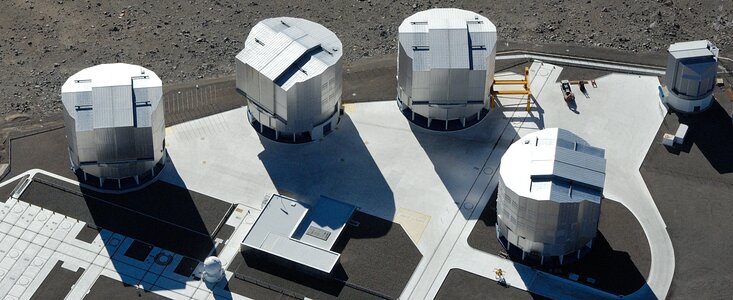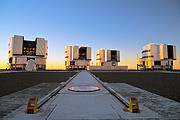Meddelelse
Two decades of discoveries with ESO’s Very Large Telescope Interferometer: happy birthday VLTI!
29. oktober 2021
Twenty years ago today, light from two of the 8.2-metre Unit Telescopes (UTs) of ESO’s Very Large Telescope (VLT) at the Paranal Observatory in Chile was combined for the first time. The event marked the historic moment when these telescopes first operated as a true interferometer, sparking the beginning of a new era for astronomy.
When the light beams of the two UTs were combined on the night of 29 October 2001, the VLTI did not only successfully start its operations, but also delivered its first scientific results: the measurement of the size of the southern star Achernar, which was found to be approximately ten times larger than our Sun. This was followed by three more nights of scientific observations, where the VLTI showcased its excellent potential by measuring ten more stars, and notably performing the first interferometric observation of the intriguing Eta Carinae.
The successful concept of the VLTI had been demonstrated some months earlier, on 17 March 2001. That night, light from another star, the bright Sirius, was collected and combined with two small telescopes (called siderostats), specially constructed for the early VLTI test stages.
The combination of light from the siderostats, and later from the UTs, was just the beginning of the journey for the interferometer. The VLTI can also function using four movable 1.8-metre diameter Auxiliary Telescopes (AT), which were completed between 2004 and 2006. In February 2005, light from two ATs was combined for the first time, marking another important milestone in the interferometer’s life. The ATs combine their light in a similar fashion to the UTs, with the difference that the ATs can be moved up to 30 different locations along the Paranal platform. This offers a whole new set of interferometric configurations, allowing the VLTI to reach its full observational potential.
Integrating the light collected by the UTs or by the ATs allows the VLTI to act as one “virtual” instrument with a diameter as large as the distance between the individual telescopes (called “baseline”). The interferometer is currently operated with baselines of up to 140 metres, depending on the position of the ATs. When the light from two UTs was first combined in October 2001, the baseline was around 102 metres, which allowed the VLTI to see details on the surface of Achernar with a resolution equivalent to seeing a 4-metre-long truck on the surface of the moon. The VLTI’s resolution, together with the individual telescopes’ ability to gather light, make the VLTI one of the most powerful optical interferometers on Earth.
Thanks to this exquisite level of detail, ESO’s VLTI has helped shed new light on many research fields in astronomy over its two decades of activity. Research carried out on VLTI data has contributed to more than 450 scientific publications since 2002. These include groundbreaking results, such as the 2020 Nobel-Prize-winning observations of stars orbiting the supermassive black hole at the centre of the Milky Way, the first direct observation of an exoplanet using optical interferometry, the highest-resolution image of the Eta Carinae star system, the detection of exozodiacal light, the best ever image of a star’s surface and atmosphere and the sharpest view of a dusty disc around an ageing star.
ESO’s VLTI could not have achieved all these stunning results without its world-class suite of instruments, including those currently in operation — PIONIER, GRAVITY and MATISSE — which saw first light between 2010 and 2018.
Links
- Very Large Telescope Interferometer
- The Messenger article on the “first fringes” with two VLT Unit Telescopes (December 2001)
- ESO Press Release: Giant Eyes for the VLT Interferometer (November 2001)
Kontakter
Antoine Mérand
VLTI Programme Scientist
European Southern Observatory
Garching bei München, Germany
Tel: +49 89 3200 6630
Email: amerand@eso.org
Bárbara Ferreira
ESO Media Manager
Garching bei München, Germany
Tel: +49 89 3200 6670
Email: press@eso.org
Om meddelelsen
| Id: | ann21015 |
Our use of Cookies
We use cookies that are essential for accessing our websites and using our services. We also use cookies to analyse, measure and improve our websites’ performance, to enable content sharing via social media and to display media content hosted on third-party platforms.
ESO Cookies Policy
The European Organisation for Astronomical Research in the Southern Hemisphere (ESO) is the pre-eminent intergovernmental science and technology organisation in astronomy. It carries out an ambitious programme focused on the design, construction and operation of powerful ground-based observing facilities for astronomy.
This Cookies Policy is intended to provide clarity by outlining the cookies used on the ESO public websites, their functions, the options you have for controlling them, and the ways you can contact us for additional details.
What are cookies?
Cookies are small pieces of data stored on your device by websites you visit. They serve various purposes, such as remembering login credentials and preferences and enhance your browsing experience.
Categories of cookies we use
Essential cookies (always active): These cookies are strictly necessary for the proper functioning of our website. Without these cookies, the website cannot operate correctly, and certain services, such as logging in or accessing secure areas, may not be available; because they are essential for the website’s operation, they cannot be disabled.
Functional Cookies: These cookies enhance your browsing experience by enabling additional features and personalization, such as remembering your preferences and settings. While not strictly necessary for the website to function, they improve usability and convenience; these cookies are only placed if you provide your consent.
Analytics cookies: These cookies collect information about how visitors interact with our website, such as which pages are visited most often and how users navigate the site. This data helps us improve website performance, optimize content, and enhance the user experience; these cookies are only placed if you provide your consent. We use the following analytics cookies.
Matomo Cookies:
This website uses Matomo (formerly Piwik), an open source software which enables the statistical analysis of website visits. Matomo uses cookies (text files) which are saved on your computer and which allow us to analyze how you use our website. The website user information generated by the cookies will only be saved on the servers of our IT Department. We use this information to analyze www.eso.org visits and to prepare reports on website activities. These data will not be disclosed to third parties.
On behalf of ESO, Matomo will use this information for the purpose of evaluating your use of the website, compiling reports on website activity and providing other services relating to website activity and internet usage.
Matomo cookies settings:
Additional Third-party cookies on ESO websites: some of our pages display content from external providers, e.g. YouTube.
Such third-party services are outside of ESO control and may, at any time, change their terms of service, use of cookies, etc.
YouTube: Some videos on the ESO website are embedded from ESO’s official YouTube channel. We have enabled YouTube’s privacy-enhanced mode, meaning that no cookies are set unless the user actively clicks on the video to play it. Additionally, in this mode, YouTube does not store any personally identifiable cookie data for embedded video playbacks. For more details, please refer to YouTube’s embedding videos information page.
Cookies can also be classified based on the following elements.
Regarding the domain, there are:
- First-party cookies, set by the website you are currently visiting. They are stored by the same domain that you are browsing and are used to enhance your experience on that site;
- Third-party cookies, set by a domain other than the one you are currently visiting.
As for their duration, cookies can be:
- Browser-session cookies, which are deleted when the user closes the browser;
- Stored cookies, which stay on the user's device for a predetermined period of time.
How to manage cookies
Cookie settings: You can modify your cookie choices for the ESO webpages at any time by clicking on the link Cookie settings at the bottom of any page.
In your browser: If you wish to delete cookies or instruct your browser to delete or block cookies by default, please visit the help pages of your browser:
Please be aware that if you delete or decline cookies, certain functionalities of our website may be not be available and your browsing experience may be affected.
You can set most browsers to prevent any cookies being placed on your device, but you may then have to manually adjust some preferences every time you visit a site/page. And some services and functionalities may not work properly at all (e.g. profile logging-in, shop check out).
Updates to the ESO Cookies Policy
The ESO Cookies Policy may be subject to future updates, which will be made available on this page.
Additional information
For any queries related to cookies, please contact: pdprATesoDOTorg.
As ESO public webpages are managed by our Department of Communication, your questions will be dealt with the support of the said Department.




